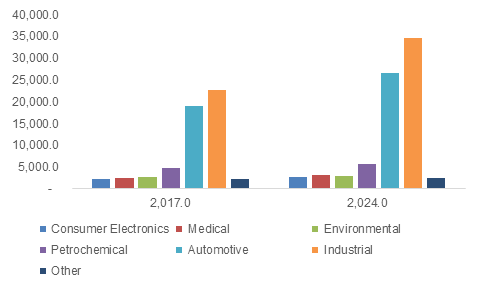Gas sensors market to accumulate considerable returns from consumer electronics applications, global industry to be characterized by a stringent regulatory framework
Publisher : Fractovia | Latest Update: 2018-11-21 | Published Date : 2016-06-19Request Sample
In an era driven by advanced technological developments, gas sensors market has emerged as one of the most profitable revenue generating spheres. Indeed, the product has been under luminous observation by several industries and researchers, that have been continuously striving to enhance the application scope of the gas sensors. As of now, these sensors have been extensively used in several industrial plants, environmental monitoring systems, and automotive technologies.
Although the research community has faced numerous obstacles while dealing with selectivity of these products, considering the parameters of sensitivity, robustness, and promptness of response, the advent of next-generation technologies like IoT and AI has considerably changed the scenario. These technologies have led to the emergence of new gas sensing mechanisms and methodologies and have been creating new opportunities for the players in the gas sensors industry.
India gas sensors market, by end-use, 2017 & 2024 (USD Thousand)

The convenience offered by gas sensors has led to their adoption by most of the consumer electronics product manufacturers who have been integrating these components in their product variants to miniaturize the devices and improve their performance. The shifting focus of the electronics product manufacturers toward miniaturizing the size of products for space saving and handy design has been encouraging sensor manufacturers to introduce innovative varieties of sensors.
Validating the aforementioned fact, recently, a renowned supplier of sensor solutions, Ams has launched a new version of low power gas sensor for detection of odors, steam, and fumes in kitchen appliances. The newly developed gas sensors are designed in a such a way that they can measure the concentration of steam and VOCs (volatile organic compound) to control the speed of a fan in the kitchen-controlled ventilation system. The fast response of advanced gas sensors to cooking processes is likely to fuel their adoption for kitchen appliances on a large scale.
Speaking about the automated and reliable functionality of the devices due to the integration of sensors, it is prudent to mention that the operation of these devices in smartphones and wearables has indeed transformed their applicability. Powered by the growing inclination of consumers toward the usage of highly innovative electronic appliances for energy efficiency and user-friendly handling, gas sensors market share from consumer electronics application was pegged around USD 150 million in 2017.
As of now, photo-acoustic gas technology is also used in most of the chemical industries for detecting gas leakage. However, this technology has to rely on sound and light to collect the data related to the gas leakage, which has instigated most of the companies dealing with hazardous gaseous chemicals to use gas sensors instead. Presently, these sensors have been installed on the robots which are usually deployed in the pipelines to identify hydrogen sulfide, petroleum, and other toxic gases leakage at chemical plants. The increasing adoption of wireless technologies at chemical plants for reducing the hazards associated with the leakage of various toxic gases is slated to stimulate gas sensors market trends over the years ahead.
Though the evolving technology trends and industrialization have brought in quite some comfort for the masses, the depleting quality of air due to the emission of pollutants from most of the industries have generated concern among regulatory bodies. On that note, in most of the countries, regulators are implementing strict norms to measure and control the emission of hazardous pollutants from these industries, that would impel the gas sensors industry trends. According to the World Health Organization, nearly 4.2 million people die annually due to outdoor air pollution. More precisely, approximately 91% of the world’s population lives in the places where WHO guideline limits are violated. This goes on to prove that the necessary action taken by the regulatory bodies and regional governments to reduce the emission of harmful pollutants and to minimize the exposure levels will boost gas sensors market size.
The shifting focus of policymakers and industrialists toward maintaining the quality of air for a healthy environment along with the surging development of miniaturized electronic appliances will have a tremendous impact on the product demand. The implementation of strict regulatory norms to overcome the hazards related to air pollution is thus slated to fuel the gas sensors industry size, anticipated to cross USD 3 billion by the end of 2024.